HVAC Modes Comparison on Corona Virus Particles
$180.00 $90.00 Student Discount
In this project, three different HVAC models were analyzed to investigate the effect of different types of ventilation inside a room, in which a corona patient breathes, on the breathing particles coming out from the patient’s mouth, and how they spread inside this room.
Click on Add To Cart and obtain the Geometry file, Mesh file, and a Comprehensive ANSYS Fluent Training Video.To Order Your Project or benefit from a CFD consultation, contact our experts via email (info@mr-cfd.com), online support tab, or WhatsApp at +44 7443 197273.
There are some Free Products to check our service quality.
If you want the training video in another language instead of English, ask it via info@mr-cfd.com after you buy the product.
Description
HVAC Modes Comparison on Corona Virus Particles Spread, ANSYS Fluent CFD Simulation Training
In this project, three different HVAC models were analyzed to investigate the effect of different types of ventilation inside a room by ANSYS Fluent software. A corona patient breathes on the breathing particles coming out from the patient’s mouth and how they spread inside this room. These types of HVAC include one-sided, cross-sided, and lateral ventilation. In each case, the airflow enters the domain through the window(s) placed on the wall boundary of the room with a velocity of 2 m/s. The discrete phase model (DPM) was activated, and the patient gave water particles out as exhaling particles with of speed of 3 m/s. RNG k-epsilon model is exploited to solve turbulent flow equations.
Geometry and mesh
The geometries of this project are designed in an ANSYS design modeler and meshed in ANSYS meshing. The dimensions of the designed room are 5m* 4.5 m*3 m.
The mesh type used for these geometries are unstructured, and the element numbers are 720274, 720153, and 720316 for on-sided, cross-sided, and lateral ventilation, respectively.
HVAC Effect CFD simulation settings
We consider several assumptions to simulate the present model:
- Simulation is done using a pressure-based solver.
- The present simulation and its results are transient.
- The effect of gravity is activated, and its value is equal to -9.81 m/s2 in the Z direction.
The following table represents a summary of the defining steps of the problem in this project and its solution:
| The applied settings are summarized in the following table. | Models | |
| Viscous model | k-epsilon | |
| k-epsilon model | RNG | |
| near-wall treatment | standard wall function | |
| Discrete phase | on | |
| Unsteady particle tracking | on | |
| Injection-0 & injection-1 | Water liquid particles | |
| Boundary conditions | ||
| Inlet | Velocity inlet | |
| Velocity magnitude (Inlet) | 2 m/s | |
| Velocity magnitude (mouth) | 3 m/s | |
| Outlet | Pressure outlet | |
| Gauge pressure | 0 Pa | |
| Walls | Stationary wall | |
| Human body | Discrete phase BC | Reflect |
| Wall-flow | Discrete phase BC | trap |
| Solution Methods | ||
| Pressure-velocity coupling | SIMPLE | |
| Spatial discretization | Pressure | Second-order |
| Density | second-order upwind | |
| Momentum | second-order upwind | |
| Energy | second-order upwind | |
| turbulent kinetic energy | first-order upwind | |
| turbulent dissipation rate | first-order upwind | |
| Initialization | ||
| Initialization method | Standard | |
| Gauge pressure | 0 Pa | |
| Velocity (x,y,z) | 0 m/s | |
| Turb. kinetic energy | 1 m2/s2 | |
| Turb. Dissipation rate | 1 m2/s3 |
HVAC Modes Comparison on Corona Virus Particles Spread Results
Contours of velocity, streamlines, etc., are obtained and presented. As shown in the presented figures, lateral ventilation has the best performance in removing the particles from the inside of the room, preventing them from facing any other hypothetical occupant in the room. However, one-sided ventilation is the worst type of HVAC to move the particles toward the outlet due to low air circulation inside the domain.
- One-sided
- Cross-sided
- lateral

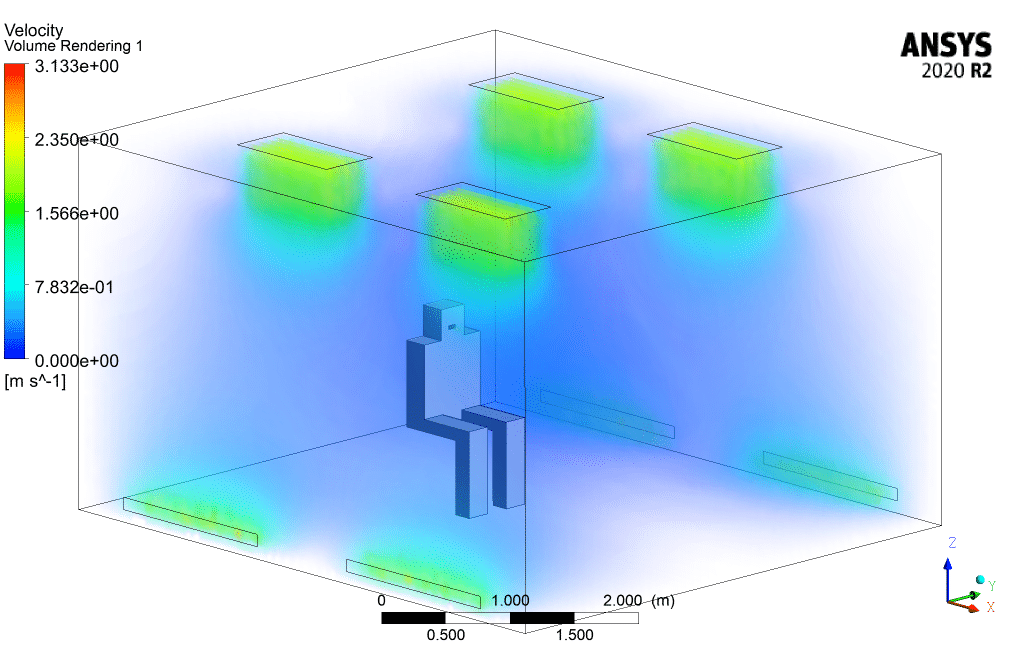
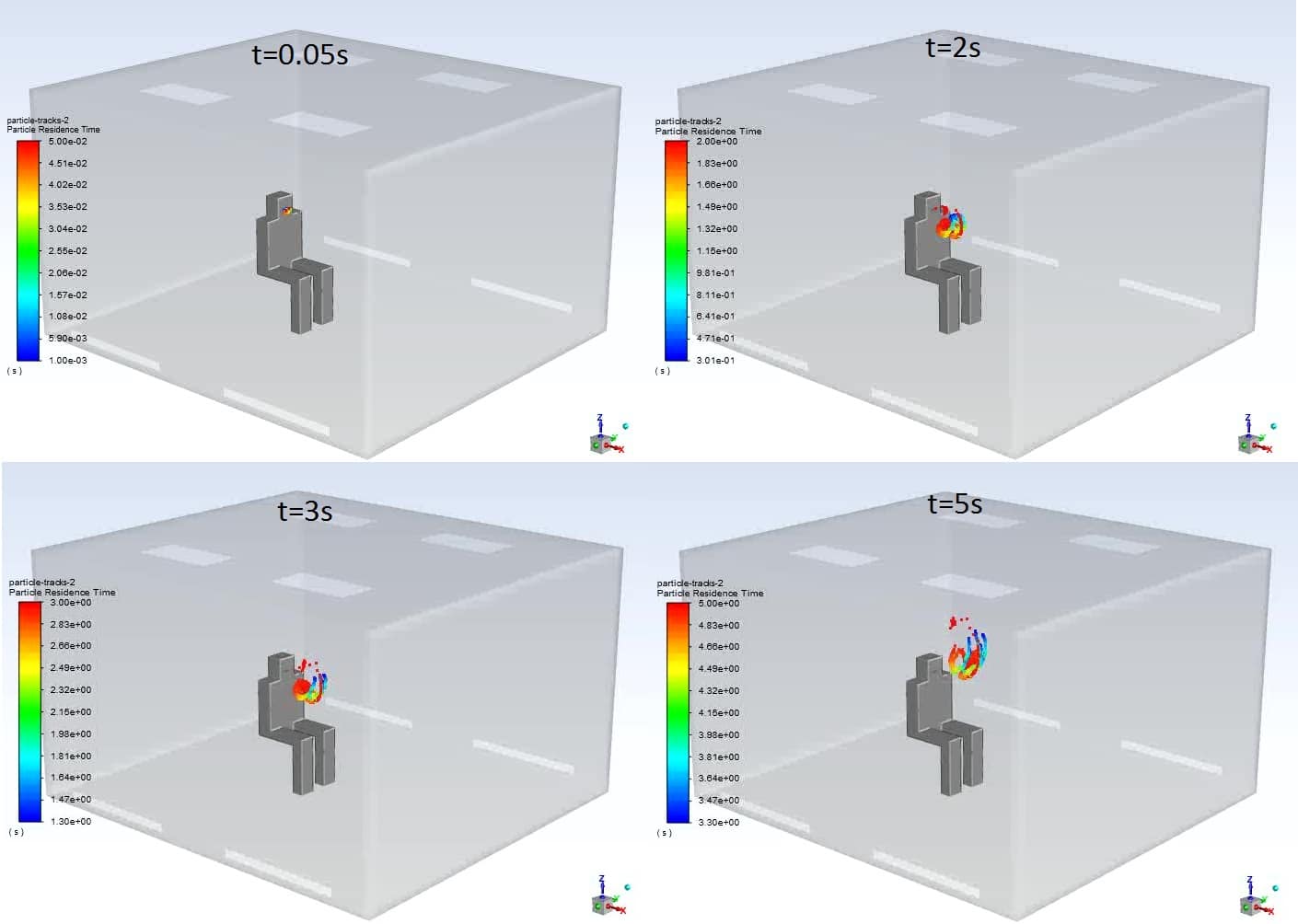
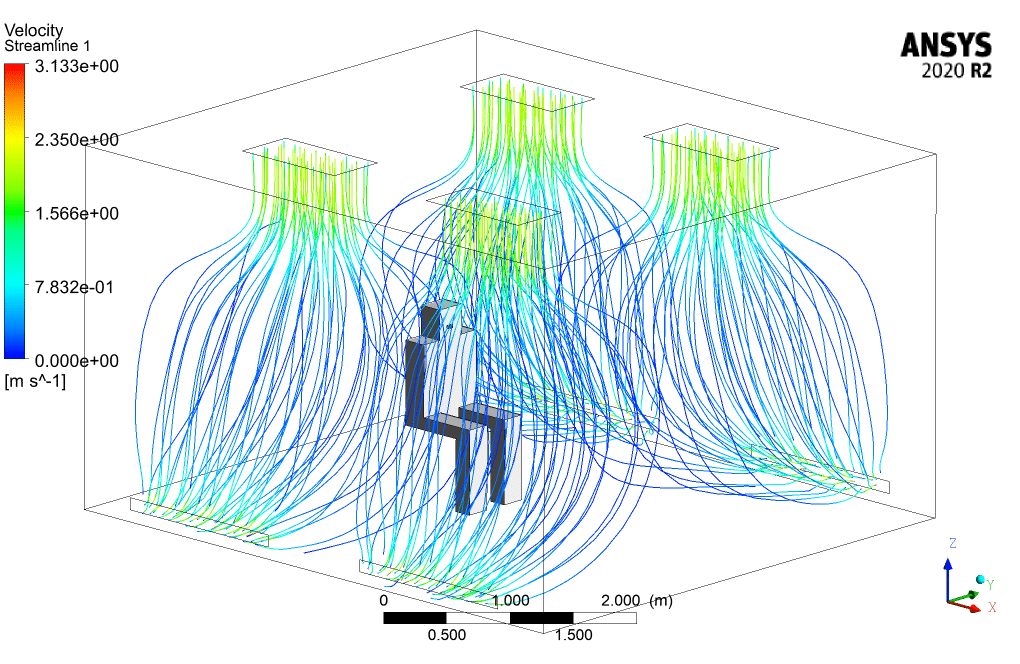
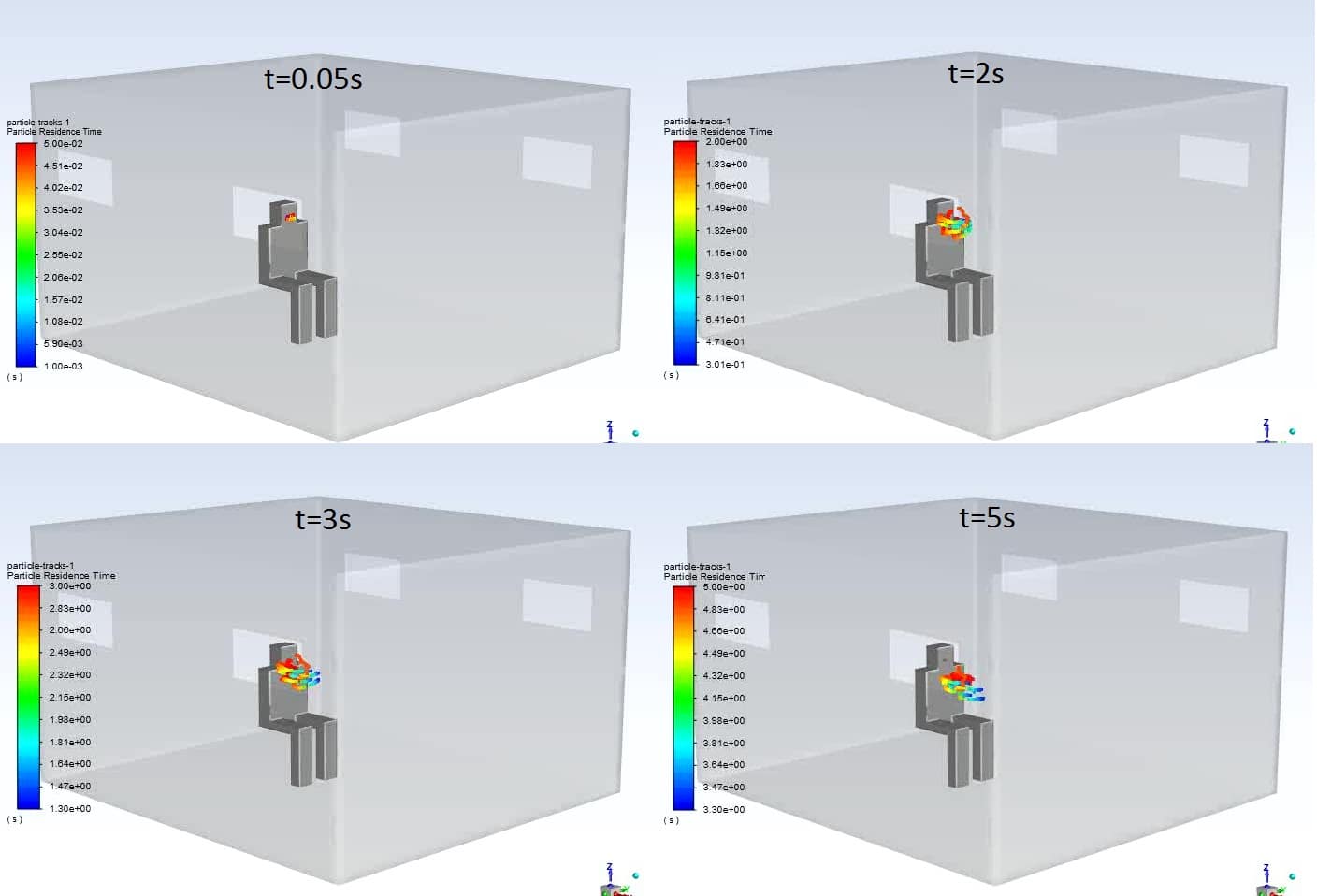
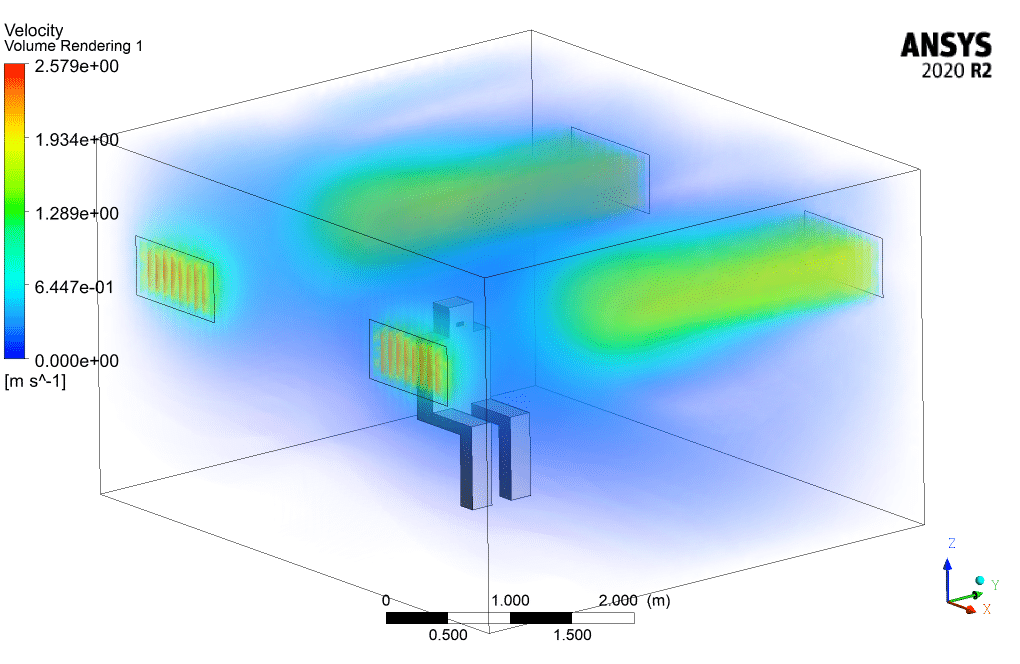
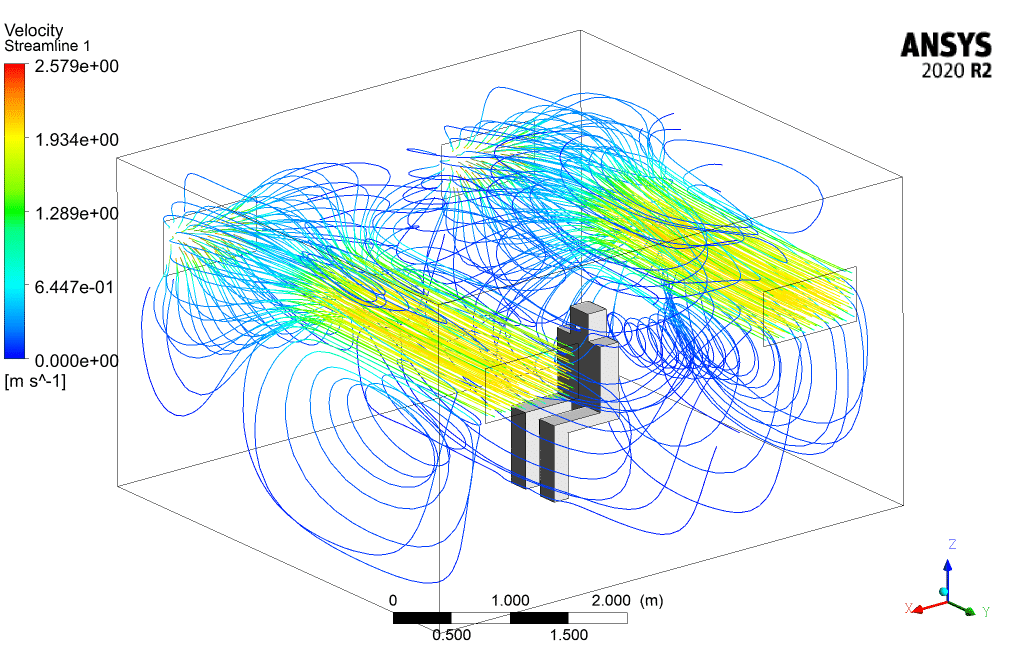
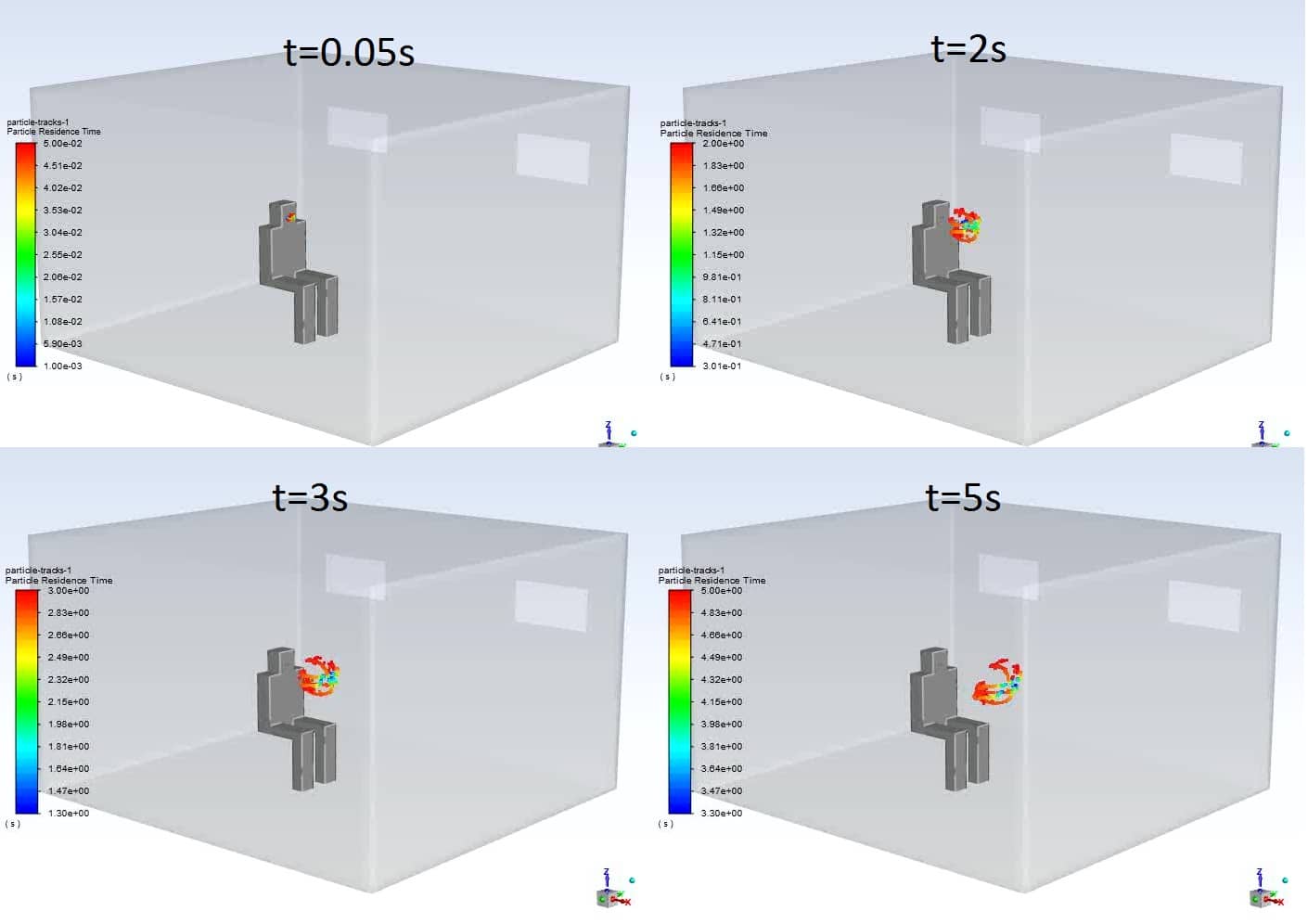
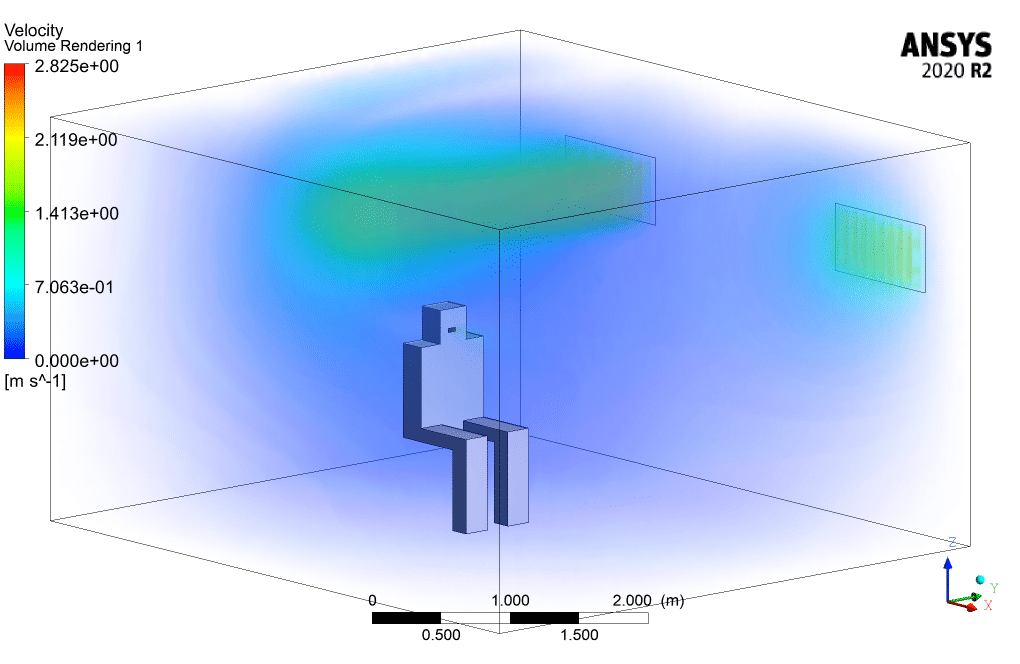
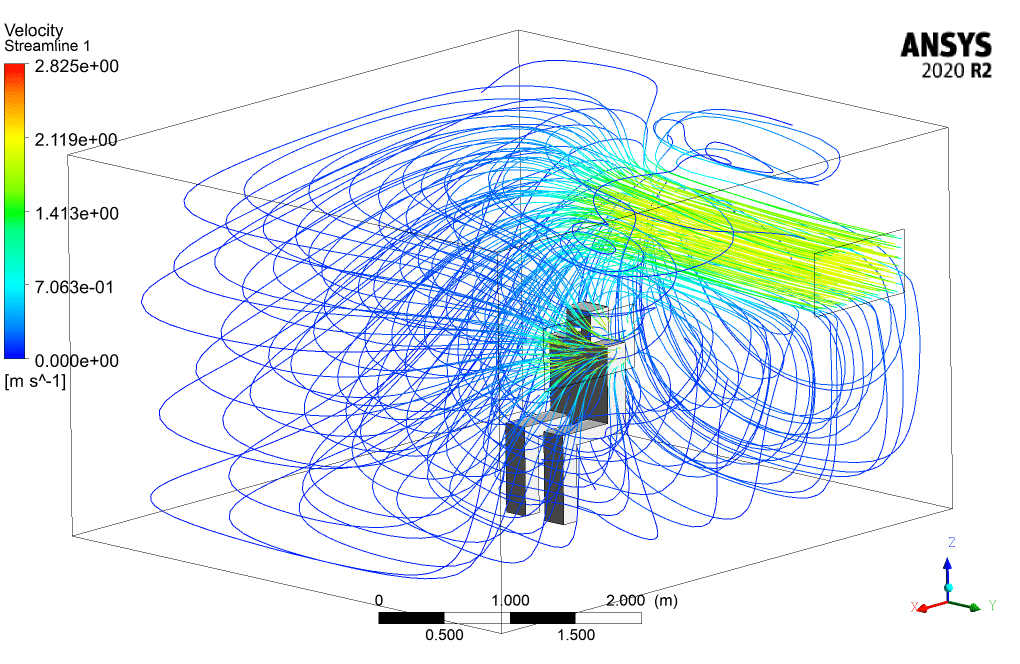
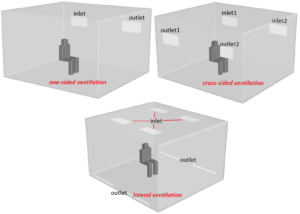
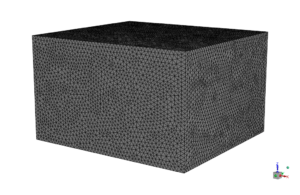
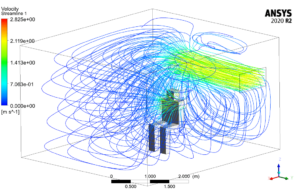
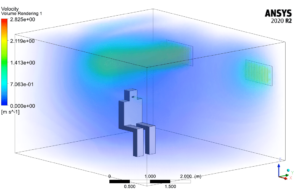
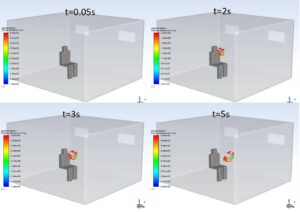
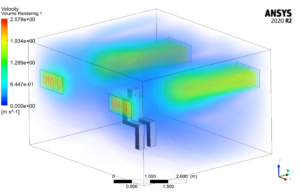
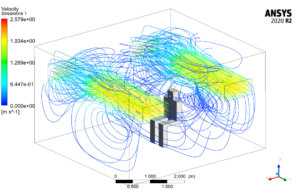
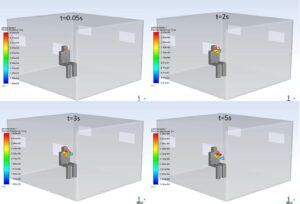
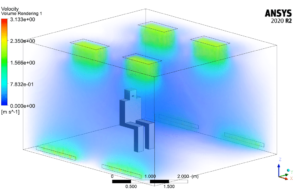
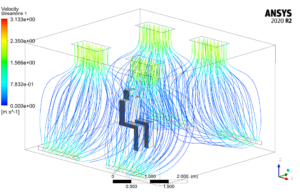
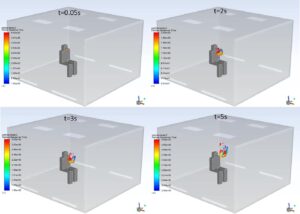

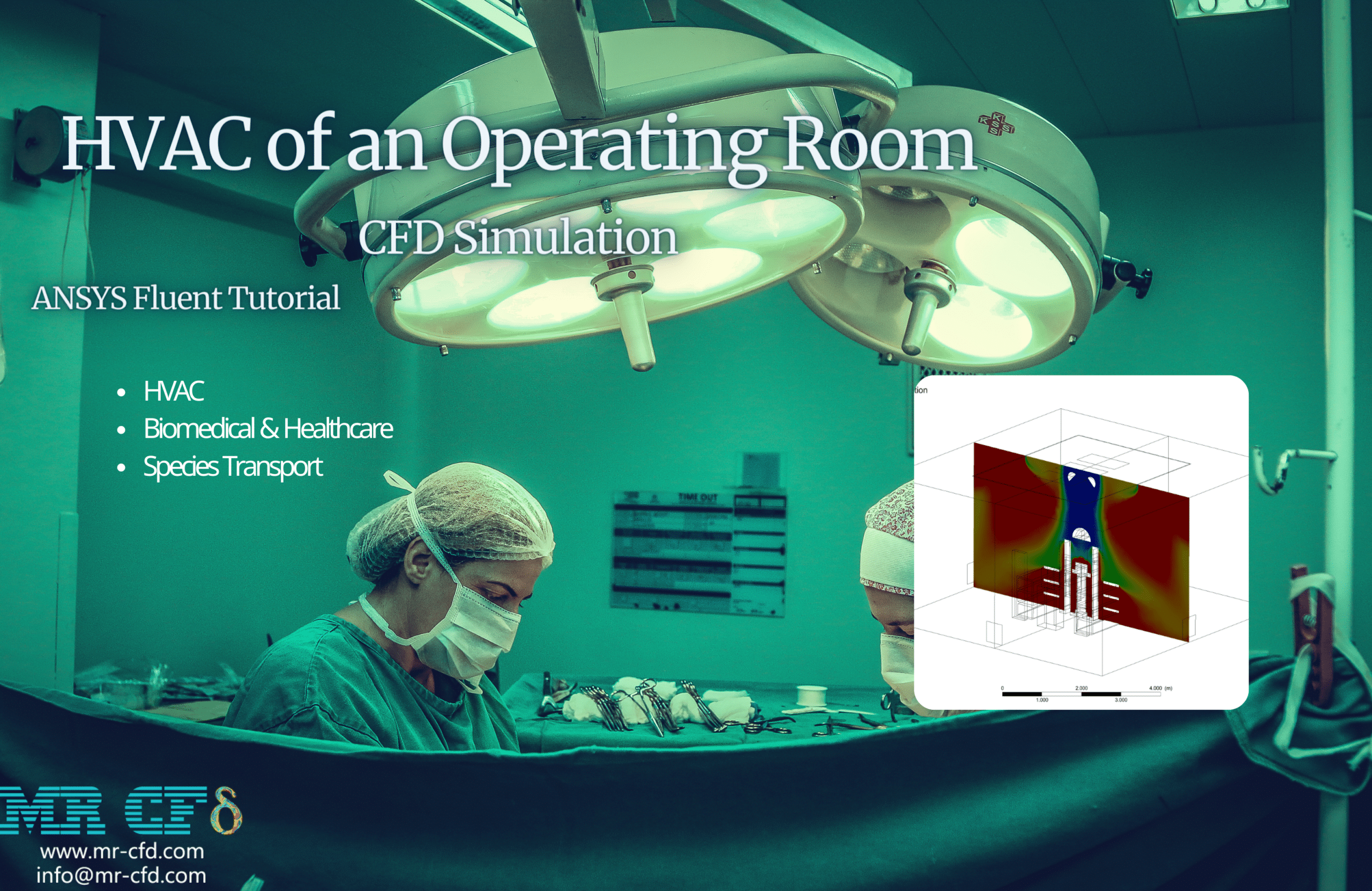
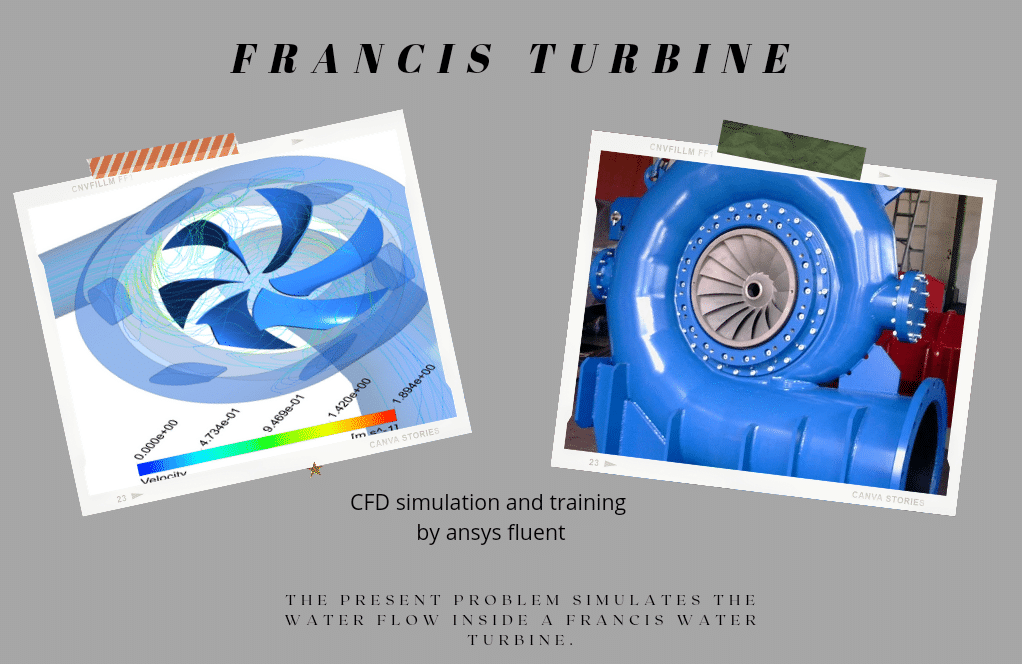

Elvis Welch PhD –
Fantastic course material on a very important and timely subject! The comparison between the different HVAC methods and how they impact the spread of virus particles in a room could be invaluable for designing safer indoor environments.
MR CFD Support –
Thank you for your positive feedback on our HVAC Modes Comparison on Corona Virus Particles CFD Simulation Training! We are glad to hear that you found the course material important and valuable. Your satisfaction is our top priority, and we aim to provide relevant and significant training for current public health concerns. We appreciate your support and look forward to delivering more quality educational material.
Maybelle Muller II –
I am extremely impressed with the clarity and detail of the coronavirus particle spread analysis using different HVAC modes. Could you please elaborate on how the efficiency of particle removal was quantified in these simulations?
MR CFD Support –
Thank you for your positive feedback! The efficiency of particle removal was quantified through the analysis of airflow patterns, particle trajectories, and the time it took for particles to exit the room or settle down. By comparing these parameters across different HVAC configurations, we determined that lateral ventilation provided the most effective means of removing particles from the room. Streamline patterns and velocity contours were instrumental in visualizing these differences.
Fernando Boyer III –
The provided simulation was extremely detailed, showing nuances of air particle flow. Brilliant work!
MR CFD Support –
Thank you for your compliment! We are glad you found our simulation on HVAC modes and their effect on virus particle spread to be detailed and informative. If you have any more interests in such simulations, feel free to explore our other offerings.
Dakota Feil III –
I was impressed with the detailed analysis of the three HVAC modes! Can you clarify which specific type of water particles were used to simulate the exhalation from the Corona patient, and why was that type chosen?
MR CFD Support –
In the studied simulation, water particles were used as a representative phase to simulate the exhalation droplets from a Corona patient because they closely mimic the characteristics of respiratory droplets in terms of density and behavior when introduced into the air. Water particles were chosen as they can be conveniently tracked using the discrete phase model (DPM) and their interaction with air flow can be realistically simulated in ANSYS Fluent to evaluate the spread of potential virus-containing particles within different air ventilation conditions.
Wilma Little –
I appreciate the detailed HVAC Modes Comparison on Coronavirus Particles. Great work on the simulations; it offered actionable insights. Lateral ventilation seems to be the effective choice for mitigating particle spread. Well done!
MR CFD Support –
Thank you for your positive feedback! We’re pleased to hear you found the simulation results helpful and actionable. If you have any further questions or need additional insights into HVAC systems and their effectiveness in reducing the spread of airborne particles, please feel free to reach out to us.
Ms. Phyllis Lemke PhD –
The detail on the removal efficiency of different HVAC setups is fascinating. Which specific ventilation setup would be most effective for a room with multiple patients?
MR CFD Support –
We’re delighted you’ve taken interest in the HVAC simulations regarding virus particle spread! According to the results showed in the study, lateral ventilation generally provides better removal of particles, suggesting this setup could be more effective in a room with multiple patients to enhance air circulation and minimize exposure. It’s advised, however, to consider the room dimensions and occupancy to fine-tune the ventilation for optimal results.
Mr. Donato Block II –
Is it possible to adjust different environmental conditions, such as temperature or humidity, to see how those factors would affect particle spread in this simulation?
MR CFD Support –
The HVAC Modes Comparison simulation focuses primarily on particle spread in direct relation to airflow patterns created by different ventilation systems. However, variations in temperature or humidity could indeed affect air density, buoyancy, and particle behavior, which in turn could impact particle spread. If looking to account for such environmental factors, additional settings and equations such as the energy equation for temperature and additional species transport for humidity might be needed in ANSYS Fluent to fully capture the complexity of the environment.
Prof. Stacy Schmidt DDS –
I’m impressed by the results comparing different HVAC systems. It’s mentioned that lateral ventilation has the best performance for removing particles. Can you elaborate on what happens to the virus particles in the one-sided ventilation scenario that makes it the least effective?
MR CFD Support –
Thank you for your positive feedback on our simulation results! In the one-sided ventilation scenario, air circulation within the room tends to be limited due to the single inlet and outlet arrangement. This situation leads to ‘dead zones’ where the air remains stagnant, not efficiently sweeping and removing the exhaled particles. Consequently, without adequate room-wide airflow, the virus particles have a higher chance of lingering in the room, thereby increasing the risk of transmission to others. Lateral ventilation, with strategically placed inlets and outlets, creates a better flow that more uniformly distributes and removes contaminants, which results in superior prevention of stagnant particle accumulations.
Madisen Cole –
I was amazed by the analysis of different HVAC modes in terms of mitigating the spread of Coronavirus within a room. It was intriguing to see how lateral ventilation outperformed the other modes. Can you share more details on how the results would influence the design of HVAC systems in public spaces or hospitals to reduce the risk of airborne virus transmission?
MR CFD Support –
Thank you for your positive feedback and insightful question! This simulation clearly demonstrates the importance of proper HVAC design in controlling airborne contaminants. Lateral ventilation’s superiority in removing particles from a room highlights the potential for vertical airflow patterns to enhance environmental safety. When designing HVAC systems for public spaces or hospitals where virus transmission risk is a major concern, a system similar to the lateral ventilation setup might be preferable. It promotes efficient air exchange, minimizes stagnant zones where particles could collect, and reduces direct airflow between occupants, all of which are crucial for mitigating the spread of airborne pathogens like the coronavirus.
Dustin Kuhn –
The comprehensive analysis and data provided offer an insightful look into HVAC effectiveness in curbing virus spread. Tremendous work on showcasing the stark contrasts among the ventilation strategies. Really elucidates the profound impacts of HVAC system configurations on health safety within indoor environments.
MR CFD Support –
Thank you for your positive feedback on our HVAC modes comparison project! We’re glad that the analysis was intuitive and provided valuable insights. Safety and real-world application are priorities in our CFD simulations, and it’s satisfying to know the impact of our work. We appreciate your review and remain committed to delivering high-quality, informative training.
Aubree Herman Sr. –
I am very impressed with the detailed analysis of the different HVAC models and their impact on airflow and possibly virus particle distribution. It’s great to see such comprehensive work, considering the actual health concerns related to air quality.
MR CFD Support –
Thank you for your kind words! We pride ourselves on providing detailed and thorough analyses to help improve understanding in critical areas such as air quality and health safety. Your positive feedback is truly appreciated, and we’re glad you found the study even more relevant considering current health concerns. If you have any more questions or need further information, please don’t hesitate to reach out.
Lane Pagac –
I had a great learning experience with the HVAC Modes Comparison on Corona Virus Particles ANSYS Fluent CFD Simulation Training. The real-world application of different ventilation models in a pandemic situation was insightful. Moreover, the methodology outlined in the project enhanced my understanding of how HVAC systems can impact airborne virus particle distribution. The clarity of the simulation processes and results really helped visualize the effectiveness of lateral ventilation in removing particles. Great tutorial!
MR CFD Support –
Thank you for taking the time to complementary feedback! We’re really glad to hear that our simulation training for HVAC mode comparisons and its impact on virus particle spread was insightful and enhanced your understanding. We are committed to providing real-world applications and valuable learning experiences. Your positive remarks on the effectiveness of lateral ventilation within our tutorial are greatly appreciated. If you have any more questions or need further help, don’t hesitate to contact us!
Ramiro Gaylord –
I purchased this CFD simulation training, and it’s fascinating to see the different ventilation effects on particle spread. What steps should be taken in a real-world scenario to optimize an HVAC system based on this study, ensuring the maximum dispersion of airborne particles?
MR CFD Support –
To optimize a real-world HVAC system, you should first assess the room’s layout and occupant distribution to understand airflow patterns. Energy efficiency and comfort levels also need to be considered. Then, perform CFD studies similar to this one to model different scenarios. Based on those results, adjust the position, type, and capacity of your HVAC vents, diffusers, and exhausts to achieve a balance between effective airborne particle dispersion, energy use, and comfort. Regular HVAC maintenance and air filter changes are also crucial. Consulting with an HVAC engineer who specializes in healthcare or infection control might provide further customization to your needs.
Jayde Jacobson –
The explanation of the simulation settings and results was very detailed. Could you specify which HVAC method, between Cross-sided and lateral, provides better airflow for quickly removing particles in areas away from the patient?
MR CFD Support –
Admin Response not required as this comment provides complement without a question.
Van Hansen –
What an enlightening analysis of HVAC systems and their effectiveness against the spread of airborne particles! The detail in your simulations certainly provides a great tool for designing healthier indoor environments. Keep up the fantastic work!
MR CFD Support –
Thank you for your kind words! We are thrilled to know you found our HVAC systems analysis valuable. It’s our goal to provide tools that assist in making indoor spaces safer, and we’re glad to be a part of such important work. We appreciate your positive feedback!
Prof. Winnifred Senger –
I’m incredibly impressed by the attention to detail in the HVAC modes analysis regarding Corona virus particle spread; the comparative approach seems comprehensive. Which ventilation setup would be best in a larger room scenario based on this study?
MR CFD Support –
Thank you for the positive feedback! Based on the current study, lateral ventilation appears to provide superior performance for particle removal in the assessed room size. For larger rooms, a similar pattern might be observed; however, it’s crucial to consider that the effectiveness can also depend on additional factors such as the room’s geometry, occupancy, and the number and location of air inlets and outlets. A specific analysis tailored to the dimensions and conditions of the larger room would provide a definitive answer.
Brianne Schulist –
The detailed simulation report on HVAC modes and their impact on Corona Virus Particles spread is incredibly informative. Especially the insights showing that lateral ventilation outperforms other methods in removing particles and reducing potential exposures within a room.
MR CFD Support –
Thank you for your appreciation! We’re pleased that the simulation provided valuable insights and could inform better decision-making regarding ventilation methods. If you have any more feedback or need further information, please don’t hesitate to ask.
Genevieve Schoen I –
I appreciate the detailed comparative study on HVAC modes and their impact on airborne particle dispersion. The efforts made to simulate realistic indoor airflow dynamics related to virus transmission are praiseworthy.
MR CFD Support –
Thank you for your positive feedback. We are pleased to know that our study has provided valuable insights into how HVAC systems can influence the spread of airborne particles. Ensuring a thorough and realistic simulation is pertinent to our commitment to safety and health, especially in these times. Your recognition of our efforts is greatly appreciated.
Felicita Satterfield –
The explanation was very detailed! The approach to assess the HVAC systems’ efficacy against the spread of coronavirus is innovative and reflects crucial real-world applications.
MR CFD Support –
Thank you for your positive feedback! We take pride in creating simulations that not only have academic value but also address real-world challenges effectively. It’s important for us to keep our training materials relevant and beneficial to our customers.
Miss Precious Dickinson –
I found the comparison of different HVAC modes fascinating. Could you please provide more information on the DPM setup, specifically on the types of injections used for modeling the corona virus particles?
MR CFD Support –
The Discrete Phase Model (DPM) in this simulation includes two types of injections: one representing the exhaled breath from the coronavirus-infected patient, and the other probably to simulate ambient particles or another point of interest. The exhaled breath particles are modeled as water droplets exiting the mouth at a speed of 3 m/s. These injections are likely to be defined with a specific size distribution, temperature, and material properties to represent the virus-laden droplets accurately. The setup aims to track the particles’ transient behavior and their interaction with the room’s airflow, influenced by the different HVAC configurations.
Jerad Ankunding –
I am very impressed with how comprehensive the HVAC modes comparison is, and it illustrates the significance of choosing the right ventilation system for controlling virus spread. Could you share more about how the ventilation efficiency in the various scenarios influences the safe occupancy duration within the room?
MR CFD Support –
Thank you for your review and interest in the HVAC modes comparison in our simulation training! The ventilation efficiency directly relates to the number of air changes per hour and the dispersion pattern of airborne particles, affecting how long it’s safe for individuals to occupy the space without a high risk of infection. Our analyses with lateral ventilation indicated improved particle removal, suggesting a safer environment for longer periods compared to one-sided ventilation, which had limited air circulation and reduced safety duration. For quantifying safe occupancy duration, it’s essential to integrate the simulation data with public health guidelines and consider factors such as source control, occupant density, and exposure time.
Yolanda Hilpert Jr. –
The study’s conclusion about the effectiveness of each HVAC mode is quite insightful. I’m particularly interested in how the DPM was set to mimic the exhalation of virus particles. Awesome work!
MR CFD Support –
Thank you for your kind words! We’re thrilled to hear that our simulation insights were helpful. In our project, the Discrete Phase Model (DPM) closely represents the trajectory and behavior of respiratory droplets under different ventilation scenarios. This implicates the importance of strategic HVAC configuration in enhancing public health safety, especially during pandemics. Your positive feedback validates our commitment to delivering practical and instructive training materials.
Benton Bailey –
This CFD simulation tutorial has been a game changer for understanding HVAC impacts on particle spread. I found lateral ventilation results quite impressive. Could you shed more light on how the simulation addresses different breathing patterns and coughs that could possibly affect particle spread differently?
MR CFD Support –
I’m thrilled to hear the tutorial was instrumental in your understanding. While this simulation focuses on a steady exhalation at a specific velocity, variations like coughing or changes in breathing patterns can indeed alter the particle trajectory and concentration. For specific inquiries regarding simulations of varied breathing patterns or the impact of coughs, adjustments to the models, additional boundary conditions, and more advanced setup may be required to capture these dynamics more accurately.
Monte Konopelski –
This was a very interesting read! I’m wondering, does the lateral ventilation setup also contribute to a quicker removal of particles compared to the other two methods, or is it just more effective in preventing spread to other occupants?
MR CFD Support –
Yes, lateral ventilation not only reduces the chance of spreading particles to other occupants by directing airflow more effectively, but it also contributes to a quicker removal of the particles from the room. This is due to the increased air circulation that it promotes, leading to a more efficient particle extraction than the other HVAC setups analyzed.
Creola Harber –
I just finished reviewing the training for the HVAC Modes Comparison on Corona Virus Particles Spread. The results were enlightening! I’m interested in knowing if the temperature of the air coming from the HVAC was factored into the simulation, and how different temperatures could affect the spread of the particles?
MR CFD Support –
In the provided simulation for the HVAC Modes Comparison on Corona Virus Particles Spread, the primary factor investigated is airflow and pattern’s influence on particle transport rather than thermal effects. The simulation does not include variations in air temperature. Typically, thermal effects could impact buoyancy and airflow patterns, which in turn could influence the behavior and spread of particles. For a comprehensive analysis, these thermal parameters would require additional simulation settings, such as the inclusion of an energy equation to track temperature fields in conjunction with fluid flow equations.
Dr. Lorna Lakin –
Just finished going through the HVAC modes comparison on virus spread using ANSYS Fluent, and I must say, it’s impressive. The comparison between one-sided, cross-sided, and lateral ventilation modes offers clear insights on which is most effective for particle removal. The level of detail and completeness, especially in how each ventilation mode affects the particle spread within the room, is commendable.
MR CFD Support –
We’re thrilled to hear that our HVAC Modes Comparison CFD Simulation Training was helpful to you! Your positive feedback motivates us to continue providing high-quality educational content. Thank you for taking the time to share your experience with our product.
Rory Brakus –
I’m really impressed with how thorough the CFD simulation was in analyzing different ventilation modes! It’s providing crucial insights for safer indoor environments. The focus on details like particle speed and differing HVAC effectiveness is commendable. Thanks for highlighting the strengths and weaknesses of each system.
MR CFD Support –
Thank you very much for your kind words and positive feedback about our HVAC Modes Comparison on Corona Virus Particles CFD Simulation training! We are thrilled to hear that the simulation provided valuable insights and that the detailed analysis of the ventilation systems met your expectations. At MR CFD, we strive to deliver in-depth and practical CFD knowledge. Thank you for choosing our learning product, and we’re here in case you have further inquiries or need assistance with other CFD applications.
Karlie Bergstrom DDS –
I’m thrilled to read how profoundly these HVAC models affect airborne virus particle spread. The analysis is incredibly relevant today, and it’s comforting to see how CFD can be used to design safer indoor environments. The detail and rigor in the study give confidence in the findings, particularly the effectiveness of lateral ventilation. Fantastic work!
MR CFD Support –
Thank you for your positive feedback on our HVAC modes comparison CFD simulation! We’re glad to hear that you appreciate the detailed analysis and relevancy to current health concerns. It’s indeed gratifying to know our work can contribute to designing safer indoor spaces. If you’re interested in more insights or have any specific questions, we’re here to help. Thanks again for your review!
Arthur Konopelski –
This training sounds intriguing! Can you tell me more about the visible representation of particles’ movement—especially their interaction with other hypothetical occupants—in the case of lateral and cross-ventilation?
MR CFD Support –
In the CFD simulation of HVAC modes comparison on Corona Virus particles spread, the lateral ventilation is especially effective in removing particles from the room and preventing them from coming into contact with other hypothetical occupants. Contours of velocity and streamlines indicate that the airflow helps direct the exhaled particles toward the ventilation outlet, reducing the likelihood of particle stagnation or spreading. For visual representation, the movement of particles is clearly defined, illustrating both the trajectory and final disposition of the particles within the room’s airflow dynamics.
Ceasar Skiles III –
I am amazed by the depth of simulation data provided! The intricate airflow patterns shown really emphasize the effectiveness of different HVAC layouts. Great analysis!
MR CFD Support –
Thank you for your positive feedback! We are thrilled to hear that our detailed simulation and analysis helped demonstrate the importance of HVAC design in particle dispersion. We appreciate your interest in our work at MR CFD Company.